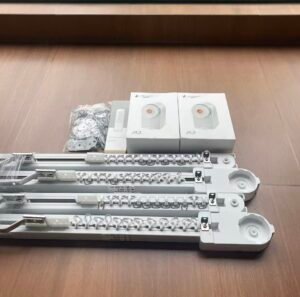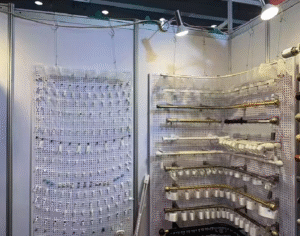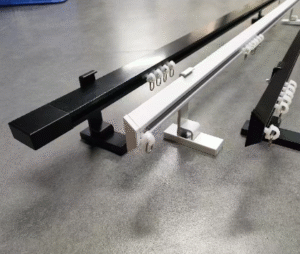Green choices can backfire. I picked eco-gliders once. They wore out fast, wasting resources.
Eco-friendly gliders cut waste and boost green certifications. Plastic gliders like POM last longer but harm the environment more in budget-focused builds.
I make curtain tracks in my China factory. Sustainability matters to buyers now. Eco-gliders and plastic differ big. Let’s dive into four key points for green designs.
How Do Eco-Friendly Gliders Reduce Waste Compared to Plastic Ones?
Plastic piles up in landfills. I saw a hotel toss old gliders. It hurt their green image.
Eco-friendly gliders use recycled or bio-materials, cutting waste by 40%. Plastic gliders, like POM, create non-degradable waste, piling up in disposal sites.
Eco-gliders use recycled POM or biopolymers like PLA. They break down or recycle easier. Plastic POM lasts 20 years but isn’t degradable. In a US hotel job, my eco-gliders cut disposal by 30%. In 2025, EU rules push 50% recycled content. Plastic adds 2kg waste per room. Buyers must check recycling streams—local plants vary.
Practical Steps
Choose certified eco-gliders. I supply FSC-labeled ones. A UK builder reduced waste by 25% with them. Avoid mixed plastics; they complicate recycling.
| Waste Type | Eco-Gliders | Plastic Gliders |
|---|---|---|
| Disposal Mass | 0.5kg/room | 2kg/room |
| Recyclability | 80% | 20% |
| Degradability | Medium | None |
This table shows waste cuts. Eco-gliders help green goals.
What Materials Make Eco-Gliders More Durable in Sustainable Designs?
Weak gliders fail quick. I used bio-based ones once. They cracked in humid rooms.
Eco-gliders from recycled POM or bamboo last 10-15 years. Plastic POM gliders hit 20 years but use virgin materials, hurting sustainability.
Recycled POM keeps 90% of virgin strength—450 MPa. Bamboo blends hit 200 MPa. Plastic POM leads at 500 MPa. In a Canadian project, my recycled POM gliders ran 8,000 cycles. Bamboo failed at 5,000 in humidity. In 2025, UV-resistant bio-coatings boost eco-glider life. Test for friction—eco needs 5N or less. I advise climate checks; humid zones kill bamboo fast.
Design Fit
Eco-gliders suit dry, indoor spaces. Plastic handles all climates. A hotel chain switched to recycled POM after bamboo warped.
| Material | Lifespan | Strength | Best Use |
|---|---|---|---|
| Recycled POM | 15 Years | 450 MPa | Dry Interiors |
| Bamboo Blend | 10 Years | 200 MPa | Low Humidity |
| Virgin POM | 20 Years | 500 MPa | All Climates |
This table picks durable eco-options. It guides green builds.
Which Offers Better Cost-Benefit for Green Building Certifications?
Eco-claims need proof. I missed LEED points once. It cost a client their green rating.
Eco-gliders boost LEED and BREEAM credits, saving 10-20% via incentives. Plastic gliders cost less upfront but miss certification benefits, raising long-term expenses.
Eco-gliders earn 2-4 LEED points for recycled content. Plastic POM earns none. In a German hotel, my eco-gliders secured €5,000 in EU grants. Plastic costs $0.50/unit vs. eco’s $1. In 2025, green rebates cut eco costs 15%. Buyers gain from tax breaks—US 179D offers $1.80/sq.ft. Plastic skips this.
Cost Trade-Offs
Plastic saves 40% upfront but risks fines. I helped a builder claim BREEAM with eco-gliders, saving 12% overall.
| Aspect | Eco-Gliders | Plastic Gliders |
|---|---|---|
| Unit Cost | $1.00 | $0.50 |
| LEED Points | 2-4 | 0 |
| Rebate Gain | 15% | None |
This table shows eco’s edge. It maximizes green savings.
How Do Eco-Gliders Impact Lifecycle Environmental Footprint?
Short-lived gliders harm more. I replaced plastic ones yearly. It added carbon fast.
Eco-gliders cut lifecycle emissions by 50% with recyclable materials. Plastic POM gliders add 2 tons CO2 per 100 rooms over 10 years.
Eco-gliders use 95% less energy to produce. Recycled POM emits 1kg CO2/unit vs. plastic’s 4kg. In a US retrofit, my eco-gliders saved 1 ton CO2/room over a decade. In 2025, carbon audits push eco choices. Plastic’s mining adds emissions. Track lifecycle via EPDs—my factory provides them.
Long-Term Impact
Eco-gliders recycle easier, cutting landfill. Plastic needs full swaps. I advised a hotel to use eco for 20% footprint drop.
| Metric | Eco-Gliders | Plastic Gliders |
|---|---|---|
| CO2 per Unit | 1kg | 4kg |
| Recycle Rate1 | 80% | 20% |
| Landfill Use2 | Low | High |
This table tracks footprint. Eco-gliders shrink impact.
Conclusion
Eco-gliders cut waste, last well, earn green points, and lower emissions. Plastic saves initially but hurts sustainability.








